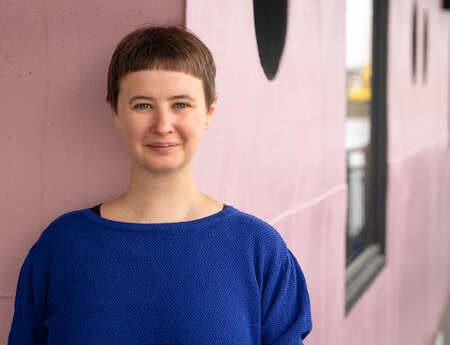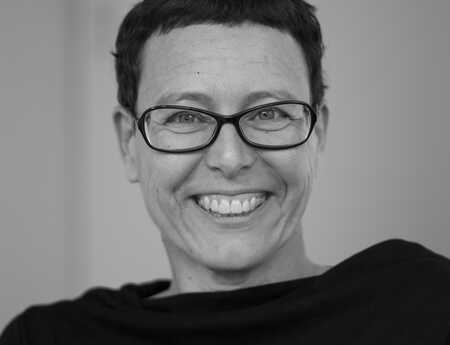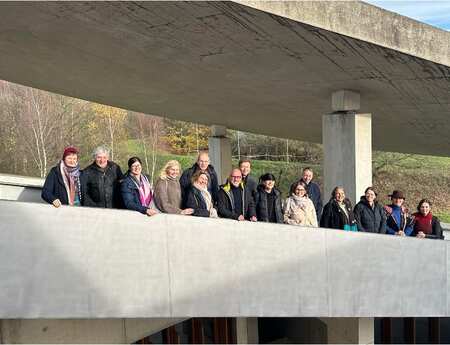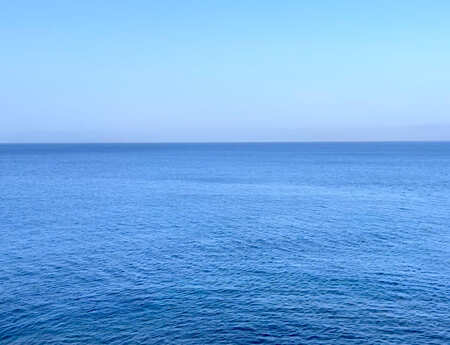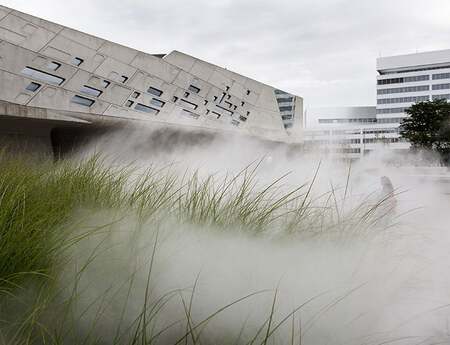How to Avoid Cocooning in our Comfort Zone? The Empowering Potential of Art
Marek Wolynski is a London-based curator, creative producer, and Sculpture Network Coordinator for the UK. With a background influenced by a family of artists and academics, Marek’s approach to art celebrates novel modes of communication and meaningful engagement with the world that surrounds us. His international projects combine technology with public engagement and sustainable consciousness. We talked to him about galleries without walls and very special friendships in Saudi Arabia, audiences facing challenging topics in London – and his passion for Sculpture Network.
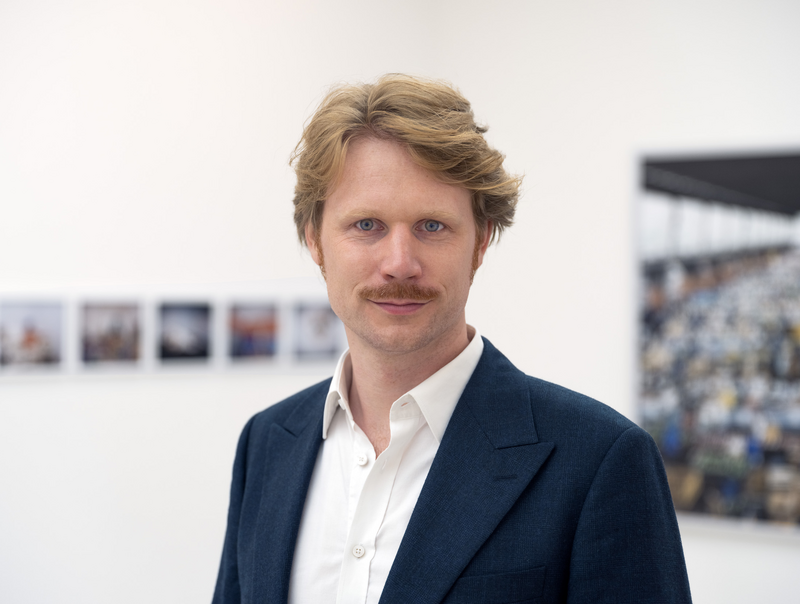
Marek, you recently curated the 4th edition of Tuwaiq Sculpture, a symposium in Saudi Arabia. Can you tell us more about this exceptional event?
Tuwaiq Sculpture is a unique platform that brings together sculptors to collaborate and create large-scale public artworks in a live setting. Through an open call, thirty artists from around the world were invited to Riyadh to work on monumental sculptures using 500 tons of local granite and limestone. Alongside the creation process, which was fully accessible to the public, Tuwaiq Sculpture engaged the public through dozens of interactive workshops and multiple panel discussions exploring three-dimensional art. Tuwaiq Sculpture is a major annual festival and part of Riyadh Art, the first national public art initiative in Saudi Arabia and most likely the largest public art project in the world.
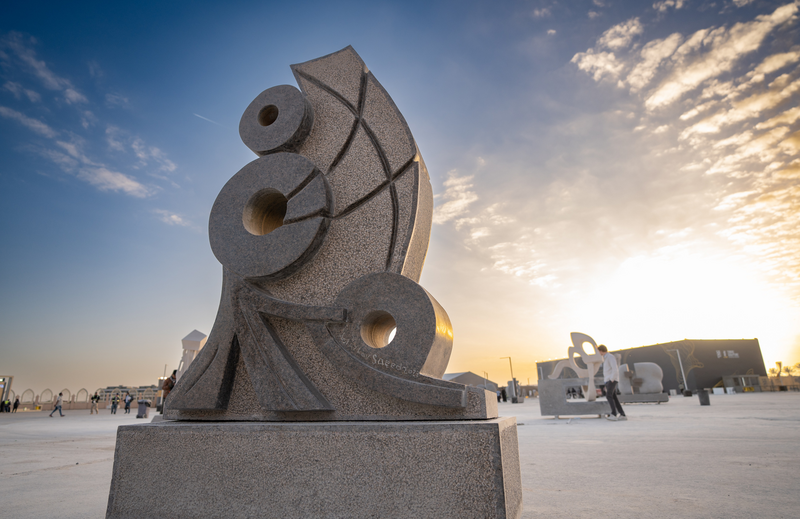
What happens with that gigantic amount of material once it has been turned into art?
The symposium significantly contributes to Riyadh Art’s goal of enriching the Saudi capital with one thousand public art installations, transforming the city into a gallery without walls. This year’s theme was Energy of Harmony which also emphasized the symbolic character of working with Saudi-sourced granite: a piece of natural stone that had been there for thousands of years and transforming it into a piece of art that subsequently became part of the urban cityscape. All the Riyadh Art artworks are strategically placed in open environments, inviting the public to engage and ignite the creativity of Riyadh’s residents and visitors alike.
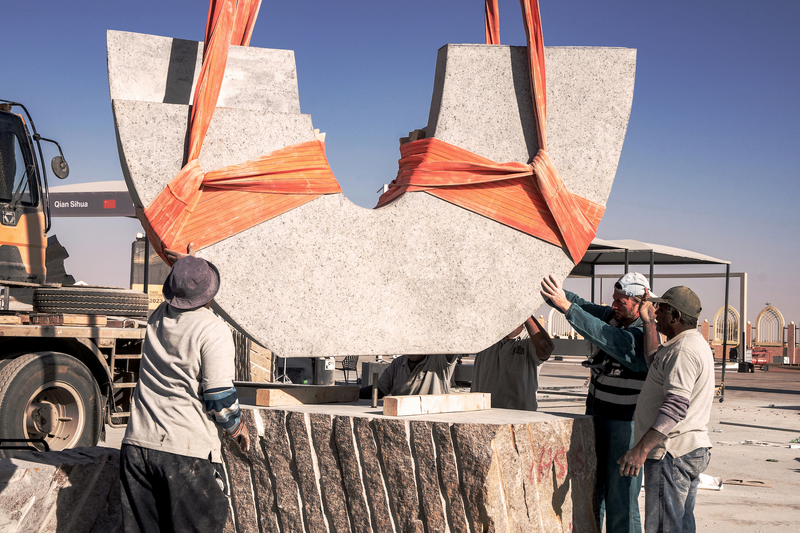
Wow, that’s a lot of works of art.
To create and distribute a thousand public artworks is ambitious indeed. Until very recently there was little contemporary art in the public realm of Saudi Arabia. Public art is becoming a new ingredient of Riyadh’s fabric, where the exchange of ideas through creative expression develops a deeper mutual understanding and respect.
How did you perceive this very special history of the country?
The transformation originates from within the society and is palpable across the country. Everyone seems to have been waiting for this moment to occur and now passionately participate in this cultural renaissance. In contrast to Europe, the majority of Saudi's growing population is young (below 30 years of age) and people want to become part of the dialogue with the whole world, welcoming everyone as the country progressively diversifies from oil and Riyadh aims to become one of the world’s most livable cities.
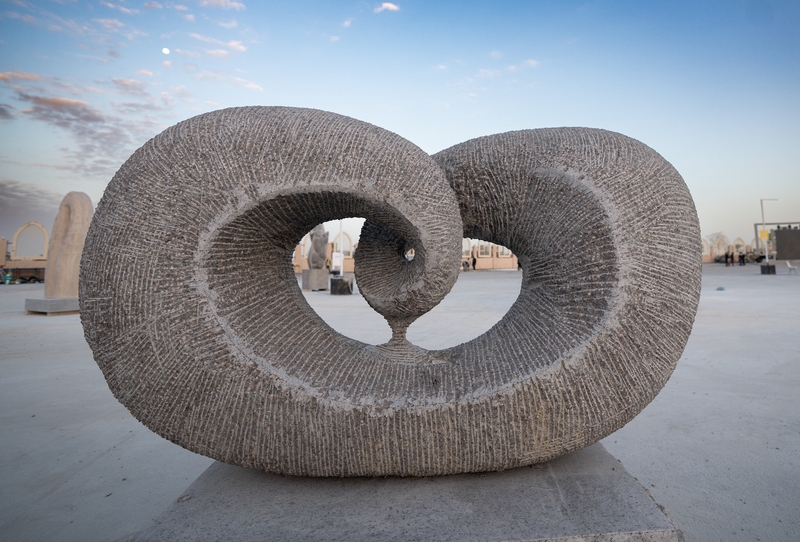
Was there one key moment during the symposium that describes this feeling for you?
I have a vivid memory of an uplifting moment during the symposium. After the active creation phase of the symposium, Tuwaiq Sculpture’s oldest participant – Tatsumi Sakai from Japan, who is nearly 70 years old and speaks next to no English – was wandering through the exhibition, appreciating the artworks. At that time, I was engaged in a conversation with a local Saudi artist, Mohammad Al-Faris, who quickly excused himself saying: “Marek, I really have to leave now. I’m taking my friend to visit my farm and then we are going to the old market.” So, I wished him a great day and said that I would say hello to Tatsumi and perhaps walk with him back to the hotel. To my surprise, Mohammad explained: “No, Marek! It is Tatsumi who is my friend! It’s him I’m taking to the market, and I have already shown him other landmarks in Riyadh”. They truly bonded even though there was no language that they had in common.
They had built up that unique connection without anyone noticing?
Yes. I feel very fortunate that I was in the right place at the right time and witnessed their friendship. They spent time together, communicating beyond language barriers. It was evident that the exceptional Arab hospitality and the innate human aspect of sharing and caring surpassed linguistic differences, politics or other barriers. At that moment, surrounded by monumental artworks, I realized that Tuwaiq Sculptures, as a platform that transcends borders and brings different communities together, bears fruit on multiple levels, exemplifying the power of art to foster meaningful connections.
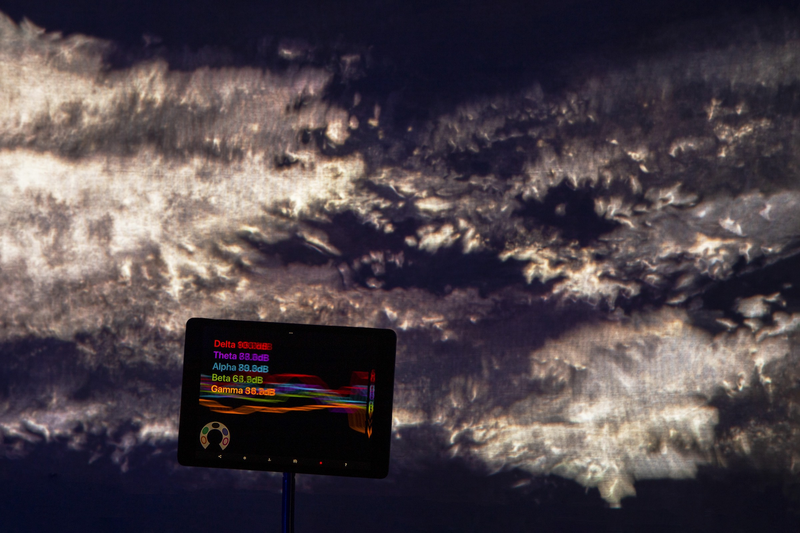
Your latest exhibition in London, Augmented Body, Altered Mind was quite an unorthodox approach to tackling the issue of climate crisis. What was the idea behind it?
Well, we all seem to know a lot about the climate crisis: we read the news, we delve into books, we watch documentaries, and hear scientists telling us facts. Yet, we tend to dismiss the environmental emergency. Developed by artist AlanJames Burns, Augmented Body, Altered Mind was an immersive and interactive artwork that explored the complex intersection of the climate challenge, our own actions, and variations in human brain and cognition. The exhibition allowed for making our invisible way of thinking visible. When something becomes visible, it’s much easier to have a discussion about it. The exhibition encouraged audiences to confront the issue in a new way, inviting meaningful dialogues and inspiring collective action.
Sounds great – but what was the actual experience like for the audience?
As you enter the gallery, the way your brain works is visualized around you in real time. You are actively co-creating the artwork using a brain-computer interface. At the same time, you are immersed in a multi-channel soundscape reminiscent of different environmental sounds: from cracking ice and gusting wind to sounds associated with moving sands and thunderstorms. The third layer of this exhibition is a dialogue on headphones where you hear two people discussing, quite humorously, cognitive abilities of our brains and their relation to climate change. AlanJames Burns’ practice challenges us to question the assumptions we often take for granted, prompting meaningful discussions about not just what we think, but how we think. Augmented Body, Altered Mind aimed to avoid didactic approaches and discussing the environment explicitly. Instead, everyone was invited to actively participate in the conversation about the environmental challenge and draw their own conclusions.
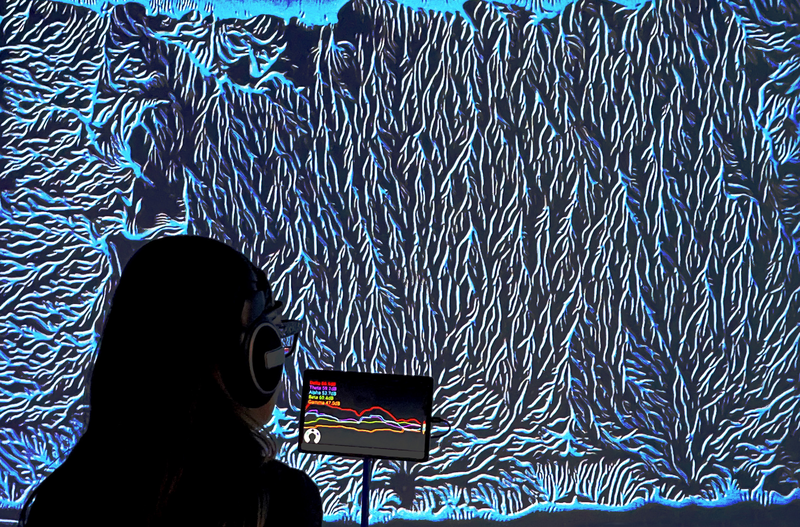
Did it work? Did the audience actually talk about the climate crisis?
Frankly speaking, the outcomes surpassed our expectations. Visitors enthusiastically discussed their own approaches to the convergence of art, science, technology, and climate change. It was incredible to witness individuals returning regularly to experience how their brains behave on different days. Feedback we received indicated that the show triggered people to think about creative tools for new world-making and thinking towards more sustainable and diverse futures, where technology serves as an aid rather than a driving force. That is one of the biggest benefits of art projects about climate challenge: they have the potential to be truly empowering.
Looking back at both projects, Tuwaiq Sculpture and Augmented Body, Altered Mind what is your basis as a curator?
As a curator, I focus on facilitating transformative experiences that forge connection and ignite inspiration. I value art that emerges from groundbreaking ideas, and I am an avid proponent of audience engagement across diverse communities. Whether it is an exhibition blending art and technology or a sculpture symposium, those environments serve as catalysts for active participation, mutual learning, and fostering connections that transcend boundaries.
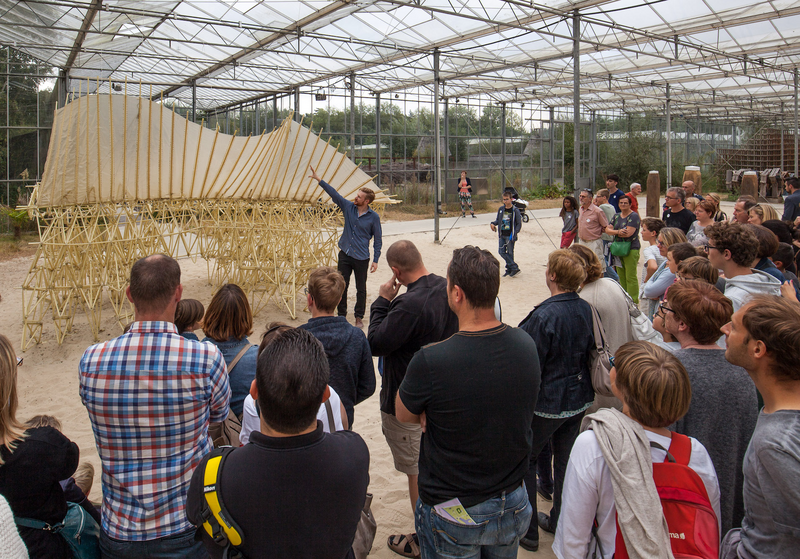
Where did you get to know Sculpture Network?
My introduction to Sculpture Network came back in 2016 when I was working as a curator at the Verbeke Foundation in Belgium, where the previous International Forum of Sculpture Network took place. Dedicated to Sculpting Nature: LandArt, BioArt, EcoArt, the Forum brought together a brilliant group of like-minded people and was a truly stimulating gathering. I got to know Sculpture Network members as well as the goals and values of the organization that align with what I aim to achieve through my projects. At that time, I curated Theo Jansen’s Strandbeest retrospective and took forum attendees on a special tour to experience the show. To this day, I remember different conversations about land art and the power of different materials in conveying artistic messages. I am already looking forward to the upcoming forum at Museo Picasso and Centre Pompidou Málaga in October this year.
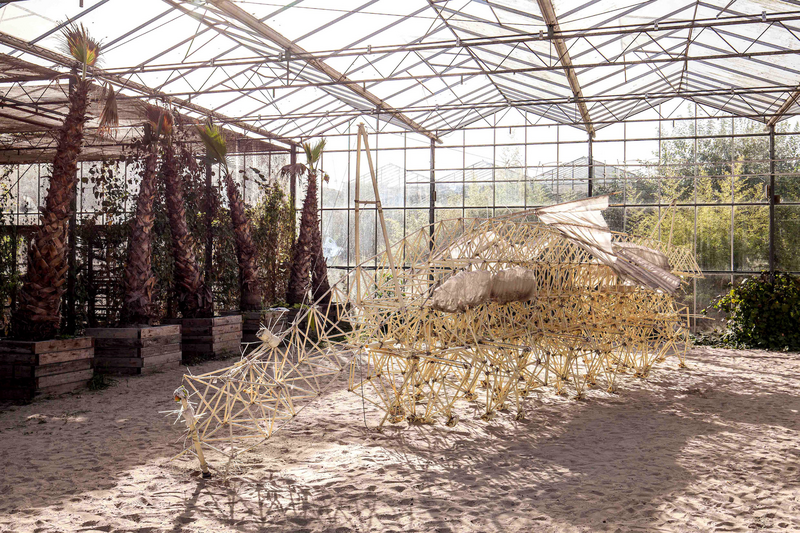
What do you appreciate about the network?
Sculpture Network holds a special place for me as it cultivates a vibrant community that nurtures the growth and development of three-dimensional art. In my view, it is a unique platform that empowers its members to shape the future of sculpture and its role in society. Without the dialogues that Sculpture Network events provide, we would stay cocooned in our comfort zones. Sculpture Network enables us to experience a multitude of perspectives and approaches to art, and to gain a deeper understanding of our practices as an artist, an art professional, or an institution. To me, Sculpture Network is an exceptional and inclusive platform that nurtures greater understanding, tolerance, and fresh perspectives.
Find out more:
Tuwaiq Sculpture 2024 – open call is now live:
https://riyadhart.sa/en/opencall/tuwaiq-sculpture-2024-open-call/
Sculpture Network XV. International Forum – register now
https://sculpture-network.org/en/event/50639/xv.-international-forum-in-málaga

